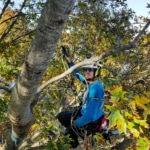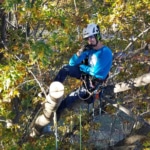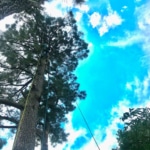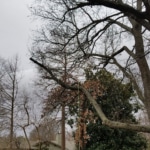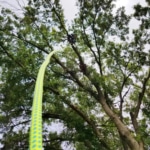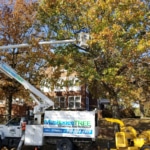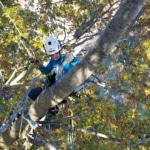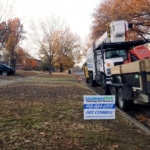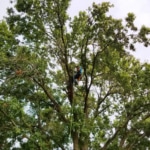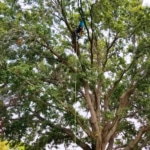Tree Pruning
- Overview
- F.A.Q.
- Pricing
Tree Pruning is one of the most complex, multi-faceted aspects of tree care. Make sure the company that you hire has a good working knowledge of Tree Biology, the differences between individual Genus and Species, and a good understanding of all the Biotic and Abiotic issues that can affect your tree's health. The ability to operate a chainsaw and cut a branch does not in itself equal a knowledgeable Tree Care Professional. The fastest way to find out if someone knows anything about Trees is to ask them to tell you about your tree. If they don't have more than one or two sentences to say, you might want to re-think hiring them to care for it.
At Muskogee Tree, we are continually improving our knowledge of Tree Biology and and our ability to provide the absolute best service possible to our customers. We care about the safety of your property, and the health of your trees. You can always rest easy knowing that your trees are in good hands with Muskogee Tree Trimming and Removal.
- My tree is too tall. Can you cut the top out of it?
- Can you raise the bottom of my tree so I can mow / walk / park under it?
- How much does Tree Pruning cost?
- Is there really a "correct" way to prune trees?
- Can I keep some of the wood?
- Will I have any options to adjust the cost?
- I have a large branch over my house. Can you just cut it off?
- Is pruning for safety more affordable than removing the entire tree?
We can perform Crown Reductions on most Genus and Species, but it's important to note that proper pruning techniques do not allow for more than a few feet (1 - 3) of reduction per pruning session (usually once per year). Tree's need vigorous and healthy canopies filled with leaves and budding branches in order to thrive. Taking off too much will have devastating effects on the tree's structure and health. If your circumstances absolutely require removing the whole top of the tree, it's usually best to just remove the tree entirely, as taking that much will most likely cause the tree to die and you'll be left with a standing hazard.
Absolutely! This service is called a Canopy Raise, and it's a very common request. We will discuss your requirements and expectations while taking into account the individual tree's growth patterns, health, and environment to formulate the best plan to meet your needs while keeping the tree strong and healthy.
Tree pruning, on average, costs between $150 and $800 per tree, but in extreme circumstances, it can cost as high as $1200 - $2000. When it comes to pruning, there are dozens of variations of type, extent, and method of service, and as no two trees (or job sites) are alike, there are several additional variables that we take into consideration when formulating your quote. For more information on these factors see the "Pricing" tab above. We always base your quote on the circumstances of the individual job as they relate to the specific items detailed in the "Pricing" tab.
This is an undeniable and emphatic YES. The International Society Of Arboriculture (ISA), various Colleges, Researchers and numerous Individuals have spent decades studying the effects of various pruning methods on just about every kind of tree imaginable. These studies are well documented and easy to find online. Because of the wealth of knowledge available, we as an industry have learned that there absolutely are harmful and inappropriate pruning practices. At the same time, it has become easy to see that certain practices are more effective and generally lead to healthier, longer living trees. Whoever you hire to prune your trees, make sure you are confident in their knowledge of Tree Biology and proper pruning methods.
Absolutely! In fact it will probably save you some money if you decide to keep some or all of the wood.
Yes. Typically we include the cost of tree pruning and disposal of the debris in one line-item for simplicity, But at your request, we can itemize every aspect of the pruning itself, from breaking down the disposal costs all the way to labor and clean-up of small debris. If you want several options for minimizing your Cost Of Service just let us know before we generate your physical quote!
The need for Hazard Reduction is the most common reason our customers request tree pruning. We've cut a lot of branches off over a ton of houses, garages, sheds, fences, pools, driveways, swingsets... you name it. While it's not always advisable to simply cut the branch all the way back to the tree, we will give you the best solutions available given your unique circumstances. Your peace-of-mind is our first job.
In most cases, it will cost less to prune your tree than it will to remove it. However, cost effectiveness is a different story. Because of the laborious and surgical nature of pruning, it takes longer in general than Tree Removal. As such, the ratio of "cost per amount of debris removed" is not usually proportional to the cost of Tree Removal, it's actually a little higher in most cases. This is one reason why the cost of paying once to have the tree removed (as opposed to paying for pruning every few years) ends up being more affordable in the long run. When we look at a tree for Hazard Reduction, nine times out of ten we're looking at a naturally large tree (Oak, Elm, Hackberry, Pecan) that is too close to the house to begin with. In these cases, Structural Pruning will meet the immediate need, but the tree will require additional maintenance pruning for the rest of its life in order to keep the hazards under control. In situations like this (big tree, too close) most of the time, pruning will cost less money up front, but removal will cost you less money overall.
That being said - we never recommend removing a tree unless it poses a direct hazard to property or life, is standing in the way of new property improvements / construction, or is a significant nuisance.
There are multiple variables taken into account that help us estimate how long any given job will take, which is the primary factor in determining your Cost Of Service. Below are the most important variables that we use to formulate your quote for Tree Pruning.
- Size And Species
- Methods Of Access
- Extrication Obstacles
- Tree Health And General Disposition
- Location And Proximity Hazards
- Disposal And Clean-Up Options
- Additional Equipment Or Subcontracted Services
When pruning a tree, it's size and species are important factors that help us determine how long it will take to maneuver inside the canopy. When circumstances require us to climb the tree, for instance, the larger the tree and the amount of it that is to be pruned can mean the difference of completing the job in a couple of hours to a full day or more. Species that naturally grow with more dense canopies, weaker wood, or hard thorns will also slow down operations considerably, but species prone to open, expansive canopies and strong wood are easier to climb and access with a bucket.
There are 3 primary methods that we use to access Trees for pruning: Bucket Truck Access, Climbing Access, and Ground Access. Each of these methods has their own strengths and weaknesses, but most often we are forced to choose the Method Of Access based on other criteria. For instance, while "Bucket Truck Access" is usually the fastest way to get around a tree, we can't always position our Bucket Truck close enough or the canopy may be too dense, and the tree may need to be climbed. Alternatively, when there are only one or two cuts that need to be made it's sometimes quicker to hang a rope and climb directly to the branches in question.
While pruning we have to take into account obstacles and hazards that may slow down the process of physically moving the cut debris from the tree to the ground. In some cases, the debris can simply be "cut and dropped" or "cut and tossed" directly from the canopy. However, in cases where there are structures, utility lines, limbs from other Trees, or other immovable objects in the drop-zone we may have to use additional rigging operations that can considerably lengthen the amount of time it takes to safely complete the pruning.
A Tree's health has a significant impact on the time it takes to safely prune it. If the tree requires extensive rigging operations to prune due to proximity hazards, we have to be certain that there are sufficient rigging points and that those points are structurally sound. If the tree is infested with parasitic organisms like Mistletoe, vines, or certain insects, it's a dead giveaway that there will be decay and cavitations inside the tree that may not be visible upon inspection as well as direct delays caused by the organisms themselves. For this reason, if a Tree is in particularly poor health or shows signs of heavy stress we have to consider that the Tree will take a little longer to safely prune.
The location of your tree another important factor in pricing. If the tree is in a field with nothing surrounding it but grass, even if it's a particularly difficult species or very large, the time it takes to prune it will be much less than if that same tree is in your backyard and hanging over your house. Because we are extremely careful when working around your personal property and home, Trees that are close to your house will take longer, as will trees that are near power lines/utilities, or that grow entangled with other trees.
Unless requested otherwise, we quote all Pruning jobs to include full disposal and clean-up of cut debris. In the cases of larger trees with more to be pruned, especially heavy Species like Oak and Pecan, disposal takes much more time, fuel, and physical labor. In the summer and autumn months, leaves add additional time to job site clean-up. These services are optional and can be itemized for inclusion/exclusion at your request.
Occasionally, on very large Trees, hard to access Trees, or Trees that are in particularly poor health, additional equipment or subcontracted services such as a Crane and Operator, Roll-off Dumpsters & Service, etc. may be required. In these instances, we will discuss all requirements with you before formulating our Quote.


